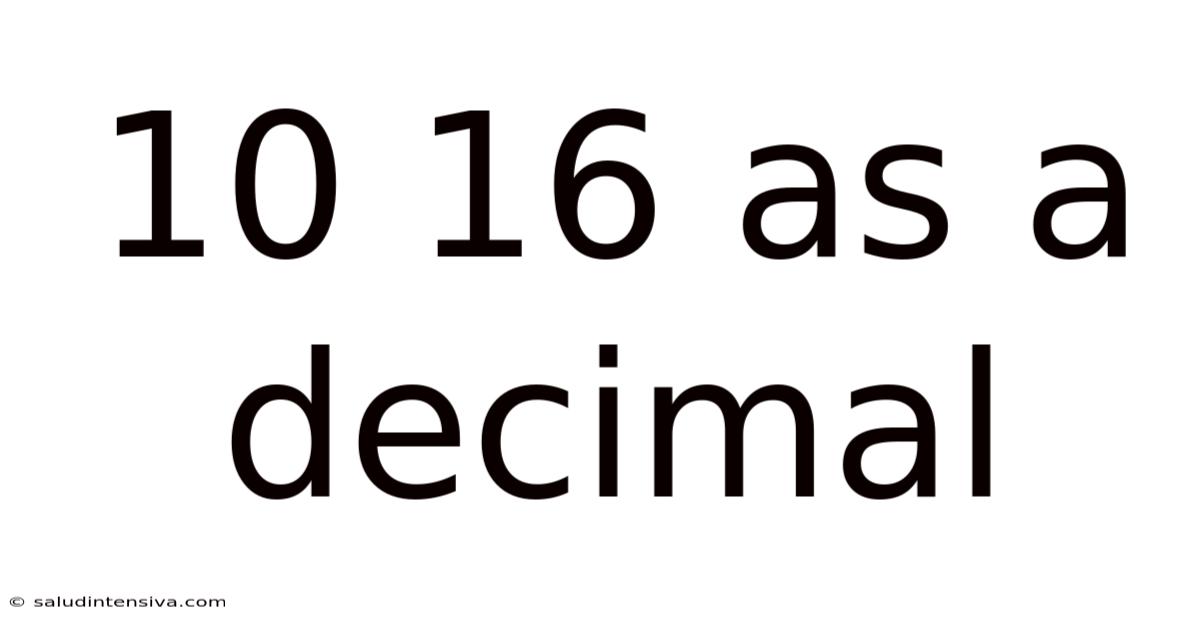10 16 As A Decimal
saludintensiva
Sep 10, 2025 · 4 min read

Table of Contents
Understanding 10/16 as a Decimal: A Comprehensive Guide
Converting fractions to decimals is a fundamental skill in mathematics, frequently encountered in various fields from everyday calculations to advanced scientific applications. This comprehensive guide will delve into the process of converting the fraction 10/16 into its decimal equivalent, explaining the steps involved, exploring different methods, and addressing common queries. We'll also examine the broader context of fraction-to-decimal conversions and their significance. This detailed explanation aims to provide a complete understanding, suitable for learners of all levels.
Understanding Fractions and Decimals
Before we begin the conversion, let's quickly recap the basics. A fraction represents a part of a whole, expressed as a ratio of two numbers – the numerator (top number) and the denominator (bottom number). A decimal, on the other hand, represents a part of a whole using the base-ten number system. The decimal point separates the whole number part from the fractional part. The conversion from fraction to decimal involves finding the decimal representation that is equivalent to the given fraction.
Method 1: Direct Division
The most straightforward method to convert a fraction to a decimal is through direct division. In this case, we need to divide the numerator (10) by the denominator (16).
-
Set up the division: Write 10 ÷ 16.
-
Perform the division: You can perform this division using long division, a calculator, or even mental math if you're comfortable with it. Long division would look like this:
0.625 16|10.000 -9.6 0.40 -32 0.080 -0.080 0 -
Interpret the result: The result of the division, 0.625, is the decimal equivalent of the fraction 10/16.
Method 2: Simplifying the Fraction First
Often, simplifying the fraction before performing the division can make the calculation easier. This is particularly helpful when dealing with larger numbers. Let’s simplify 10/16:
-
Find the greatest common divisor (GCD): The GCD of 10 and 16 is 2.
-
Divide both the numerator and the denominator by the GCD:
10 ÷ 2 = 5 16 ÷ 2 = 8
-
The simplified fraction: The simplified fraction is 5/8.
-
Perform the division: Now, divide 5 by 8:
0.625 8|5.000 -4.8 0.20 -0.16 0.040 -0.040 0 -
The decimal equivalent: The result is again 0.625, demonstrating that simplifying the fraction doesn't change its decimal equivalent.
Method 3: Using Decimal Equivalents of Common Fractions
Knowing the decimal equivalents of common fractions can significantly speed up the conversion process. For instance, knowing that 1/8 = 0.125, we can easily calculate 5/8:
5/8 = 5 * (1/8) = 5 * 0.125 = 0.625
Understanding the Result: 0.625
The decimal 0.625 represents six tenths, two hundredths, and five thousandths. It's crucial to understand the place value of each digit after the decimal point. This understanding is essential for various mathematical operations and applications.
The Significance of Decimal Conversions
Converting fractions to decimals is a vital skill for several reasons:
-
Ease of Comparison: Decimals are often easier to compare than fractions, particularly when comparing fractions with different denominators. For instance, comparing 0.625 and 0.7 is simpler than comparing 10/16 and 7/10.
-
Calculations: Performing arithmetic operations (addition, subtraction, multiplication, division) is generally easier with decimals than with fractions.
-
Real-world Applications: Decimals are widely used in various fields, including finance, engineering, science, and everyday life (e.g., measuring lengths, weights, and volumes).
Further Exploration: Recurring Decimals
Not all fractions convert to terminating decimals like 0.625. Some fractions result in recurring decimals (also known as repeating decimals), where one or more digits repeat infinitely. For example, 1/3 converts to 0.3333... Understanding the difference between terminating and recurring decimals is important for advanced mathematical concepts.
Frequently Asked Questions (FAQ)
Q1: Can I use a calculator to convert 10/16 to a decimal?
A1: Yes, absolutely. Simply enter 10 ÷ 16 into your calculator.
Q2: Is there a way to convert the decimal 0.625 back to a fraction?
A2: Yes. You can express 0.625 as 625/1000. Then, simplify this fraction by finding the greatest common divisor and dividing both the numerator and the denominator by it. The GCD of 625 and 1000 is 125. Dividing both by 125 gives us 5/8, which simplifies further to 10/16.
Q3: Why is simplifying the fraction before division sometimes helpful?
A3: Simplifying reduces the size of the numbers involved, making the division process easier and less prone to errors. It also often results in a smaller, more manageable decimal that’s easier to interpret.
Q4: Are there other methods to convert fractions to decimals?
A4: While direct division and simplifying are the most common methods, there are other techniques, particularly for certain types of fractions. These might involve using known decimal equivalents of simple fractions or applying more advanced mathematical principles.
Conclusion
Converting the fraction 10/16 to a decimal is a straightforward process achievable through several methods. The resulting decimal, 0.625, represents the same value as the original fraction. Understanding this conversion process is crucial for various mathematical applications and real-world scenarios. Remember, mastering this seemingly simple skill builds a strong foundation for more advanced mathematical concepts and problem-solving. Practice makes perfect, so try converting other fractions to decimals to strengthen your understanding and confidence.
Latest Posts
Latest Posts
-
Lcm Of 16 And 6
Sep 10, 2025
-
6 8 Divided By 2
Sep 10, 2025
-
Lcm Of 6 10 15
Sep 10, 2025
-
Centigrade To Degrees Celsius Converter
Sep 10, 2025
-
What Does 1 4 Equal
Sep 10, 2025
Related Post
Thank you for visiting our website which covers about 10 16 As A Decimal . We hope the information provided has been useful to you. Feel free to contact us if you have any questions or need further assistance. See you next time and don't miss to bookmark.